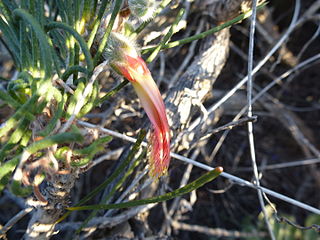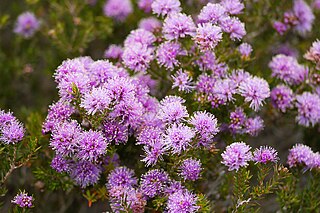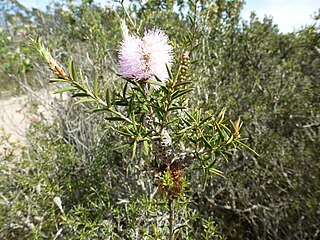
Calothamnus is a genus of shrubs in the family Myrtaceae and is endemic to the south-west of Western Australia. The common names one-sided bottlebrush or claw flower are given to some species due to their having the flowers clustered on one side of the stem or because of the claw-like appearance of their flowers. Calothamnus species are generally medium to tall woody shrubs with crowded leaves. In most species the leaves are crowded and linear in shape, and the flowers are usually arranged in dense clusters. The petals are small and fall off the flower soon after it opens but the stamens are long, numerous and usually bright red.

Melaleuca huegelii, commonly known as chenille honey-myrtle, is a plant in the myrtle family, Myrtaceae and is endemic to the south-west coastal areas of Western Australia. It has small, almost scale-like leaves and flower spikes sometimes more than 100 millimetres (4 in) long on the ends many of its branches.

Melaleuca elliptica, commonly known as the granite bottlebrush is a plant in the myrtle family, Myrtaceae and is endemic to the south of Western Australia. The Noongar name for the plant is gnow. It is commonly grown in gardens because of its neat foliage and showy, bright red flower spikes although it needs to be pruned regularly to avoid becoming woody and untidy-looking. In nature, it usually grows in the shrub layer in mallee woodland or heath.

Calothamnus chrysanthereus , commonly known as claw flower is a plant in the myrtle family, Myrtaceae and is endemic to the south-west of Western Australia. It is an erect shrub with needle-shaped leaves crowded on the ends of the branches and bright red flowers in spring.

Melaleuca squamea, commonly known as swamp honey-myrtle, is a plant in the myrtle family, Myrtaceae and is endemic to south eastern parts of Australia, especially Tasmania. It is an erect shrub growing in damp and swampy places with crowded leaves and many heads of pink to purple flowers in spring.

Melaleuca pentagona is a plant in the myrtle family Myrtaceae and is endemic to the south of Western Australia. It is a showy, medium-sized shrub which produces large numbers of pink flowers in spring. There are three varieties recognised, one of which has been known in cultivation for many years.

Melaleuca striata is a plant in the myrtle family, Myrtaceae, and is endemic to the south of Western Australia. It has distinctive leaves and heads of pink to mauve flowers, usually in late summer.

Melaleuca thymoides is a plant in the myrtle family, Myrtaceae, and is endemic to the south-west of Western Australia. It is usually a low shrub. The ends of the branches usually end in a sharp spine and the leaves also have a sharp point. Bright yellow flowers appear on the ends of the branches in spring or early summer.

Calothamnus brevifolius is a plant in the myrtle family, Myrtaceae and is endemic to the south-west of Western Australia. It is a small, highly branched shrub with almost cylindrical, pointed leaves and red flowers in summer. In 2014 Craven, Edwards and Cowley proposed that the species be renamed Melaleuca hawkeswoodii.

Calothamnus aridus is a plant in the myrtle family, Myrtaceae and is endemic to central parts of Western Australia. It is an erect, densely branched shrub with many stems, needle-like leaves and orange-red to pinkish flowers, growing in arid areas with spinifex.
Calothamnus arcuatus is a plant in the myrtle family, Myrtaceae and is endemic to the south-west of Western Australia. It is a shrub with prickly, cylindrical leaves with a slight, upward curve and bright red flowers in small groups near the older leaves.
Calothamnus cupularis is a plant in the myrtle family, Myrtaceae and is endemic to the south-west of Western Australia. It is a similar shrub to Calothamnus formosus but has larger flowers and fruit.
Calothamnus formosus is a plant in the myrtle family, Myrtaceae and is endemic to the south-west of Western Australia. It is a large, spreading, densely foliaged shrub with almost cylindrical, pointed leaves and red flowers in spring or summer. There are two subspecies, differing mainly in the length of their leaves.
Calothamnus glaber is a plant in the myrtle family, Myrtaceae and is endemic to near-coastal areas in the south-west of Western Australia. It is a shrub, similar to Calothamnus blepharospermus but its leaves are slightly longer and narrower and the parts of its flowers are glabrous.

Calothamnus hirsutus is a plant in the myrtle family, Myrtaceae and is endemic to the south-west of Western Australia. It is a small, spreading shrub with prominent hairs on the leaves giving them a smoky appearance. The flowers are deep red and are usually in dense clusters between the older leaves.

Calothamnus longissimus is a plant in the myrtle family, Myrtaceae and is endemic to the south-west of Western Australia. It is a small, spreading shrub with unusually long, fine leaves and which produces clusters of red flowers in spring.
Calothamnus oldfieldii is a plant in the myrtle family, Myrtaceae and is endemic to the south-west of Western Australia. It is a small, spreading shrub with needle-shaped leaves and clusters of red flowers with 5 petals and 5 stamen bundles.
Calothamnus phellosus is a plant in the myrtle family, Myrtaceae and is endemic to the south-west of Western Australia. It is a tall, spreading shrub with needle-shaped, prickly leaves and bright red flowers with five stamen bundles.

Calothamnus preissii is a plant in the myrtle family, Myrtaceae and is endemic to the south-west of Western Australia. It is a low-lying, sometimes ground-hugging shrub with needle-like leaves and reddish-purple flowers in spring.
Calothamnus superbus is a plant in the myrtle family, Myrtaceae and is endemic to the south-west of Western Australia. It is an erect, often spreading, straggly shrub similar to Calothamnus aridus with its red flowers having 5 stamen bundles, but its leaves are longer and wider. It has a limited distribution near Pigeon Rocks south of Lake Barlee.















